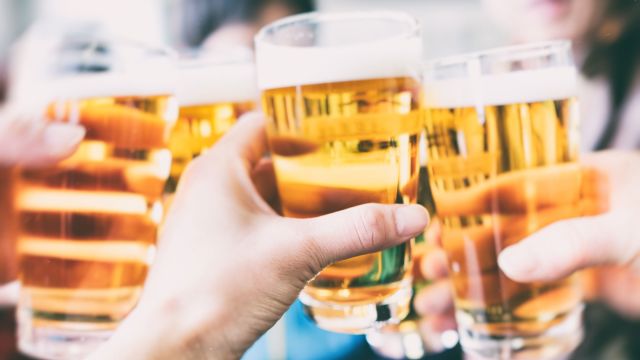Updated on September 13, 2022.
Binge drinking is the most expensive and deadly type of extreme alcohol use in the United States, according to the Centers for Disease Control and Prevention (CDC). It’s also the most common.
Approximately 24 percent of individuals aged 12 years and older reported binge drinking in the previous month, according to the 2019 National Survey on Drug Use and Health published by the Substance Abuse and Mental Health Services Administration (SAMHSA). It’s not just young adults binge drinking either.
A 2019 study published in the Journal of the American Geriatrics Society suggested that more than 1 in 10 seniors binge drink. The study authors developed this estimate based on data collected between 2015 and 2017 from nearly 11,000 adults aged 65 and older. They also found that those who binged were more likely to be men and had higher rates of tobacco and cannabis use compared to those who did not.
What does this mean for Americans? Which states have the highest rates of binge drinking? And what can you do about binge drinking? Justin Hatch, LCSW, a social worker at Ogden Regional Medical Center in Utah, shares some insights.
What is binge drinking?
The National Institute on Alcohol Abuse and Alcoholism defines binge drinking as a form of drinking that causes blood alcohol concentration levels to rise to 0.08 or higher. For women, this usually happens after consuming about four drinks within a two-hour window. For men, this happens after about five drinks within that time span.
No level of drinking is without risk. If you do drink, experts advise limiting intake to two drinks per day for men and one drink per day for women. The more you go above those guidelines, the greater your risk for serious harms including:
- Car crashes
- Alcohol poisoning
- Sexually transmitted infections
- Unplanned pregnancies
- High blood pressure
- Alcohol addiction
- Memory and learning problems
- Injury or violence, including homicide, suicide and sexual assault
Excessive alcohol intake may also raise your risk of developing certain cancers like breast, mouth, throat, esophagus, liver, and colorectal cancer.
Who tends to binge drink the most?
While adults of all age groups binge drink, it’s most commonly reported among those aged 18 to 34, according to the CDC. Men are twice as likely to binge drink as women. Additionally, white Americans and those with a combined household income of more than $75,000 are more likely to report binge drinking.
Binge drinking is also more prevalent in some states than others. According to 2018 data from the Behavioral Risk Factor Surveillance System, these states had the highest rates of residents who binge drink:
- Wisconsin: 25.8 percent
- Iowa: 24.5 percent
- North Dakota: 22.7 percent
- District of Columbia: 22.5 percent
- Nebraska: 22.5 percent
- South Dakota: 22.3 percent
- Minnesota: 21.7 percent
- Massachusetts: 21.1 percent
Signs of binge drinking
Warning signs of binge drinking include:
- Drinking more alcohol than you planned to drink
- Feeling like you’re unable to stop drinking
- Blacking out or having trouble remembering what happened while drinking
- Acting dangerously or violently while drinking, like getting into fights or having unprotected sex
The path toward recovery from binge drinking
People who binge drink may not think they have a problem because they aren’t drinking alcohol all the time. But most people with any sort of addiction go through a series of phases on the way toward recovering from their habit, says Hatch. These include:
- Pre-contemplative phase: They haven’t recognized they have a problem.
- Contemplative phase: They’ve recognized a problem but are unsure about whether they want to stop.
- Preparation phase: They start to prepare to make a change.
- Action phase: They take the steps needed to recover.
- Maintenance phase: They work to maintain their change and cope with any relapses that may occur.
How to handle an individual situation depends greatly on the particular phase. Whatever the phase, it’s important to show kindness and compassion when working with someone who has a drinking problem.
“Approach with understanding,” Hatch says. “In most cases, it’s not beneficial to shame the person or give them ultimatums.”
For those in the pre-contemplative phase, the person has to realize they have a problem. Hatch says you can start the conversation by saying things like, “I’m concerned about you.”
If someone is in the contemplative or preparation phase, you can support them by encouraging them and helping them find the additional support they need. Urge them to consult with a healthcare provider. You may also try pointing them in the direction of organizations like Alcoholics Anonymous or Smart Recovery, groups that provide reading materials, online worksheets for reflection, and in-person meet-ups and counseling.
Here are some of the other ways you or a loved one can work toward getting binge drinking under control:
Be mindful of who you spend time with. Try to avoid situations or people who encourage heavy drinking. You may want to limit your time at bars, restaurants, and parties until you feel comfortable abstaining from alcohol.
Keep a list of reasons you want to stop. Writing down the reasons you want to quit binge drinking can help you stay motivated. You can include things like "feeling healthier and more rested" or "having a better attitude."
Talk to friends and family. Let someone you trust know what you’re going through. Share the ups and downs so they can encourage you along the way and lift you up on bad days.
Consider taking a break from alcohol. Some binge drinkers find it beneficial to completely abstain from alcohol during the recovery process. If that doesn’t seem like the best option, try limiting how much you drink. You can limit the number of drinks, the types of alcohol you drink, or only drink during certain hours of the day.
Replace drinking with other activities. During the times you would normally drink, try focusing your energy on something else, like exercise or meditation.
Reward yourself. When you reach a goal, such as going a week without binge drinking or abstaining from drinking during a social event, treat yourself to something you enjoy, like a manicure, a trip to the beach, or a good book.
Binge drinking is on the rise—but is preventable
Binge drinking has become a part of American culture. We see it in movies, at sporting events, and beyond. It’s a growing problem for teens and adults of all ages and at college campuses around the country.
The good news is there are numerous resources to help you or a loved one overcome binge drinking. The first step is realizing there is a problem. Once you’ve done that, it’s important to talk about the issue with others and seek resources to help you work through it.







